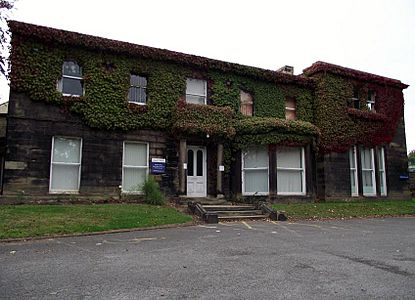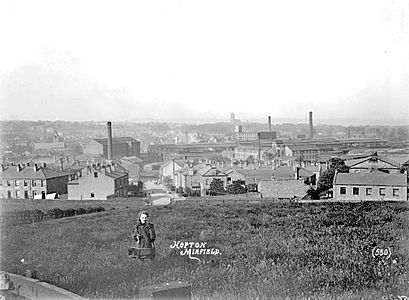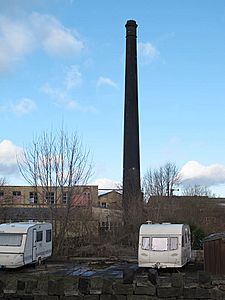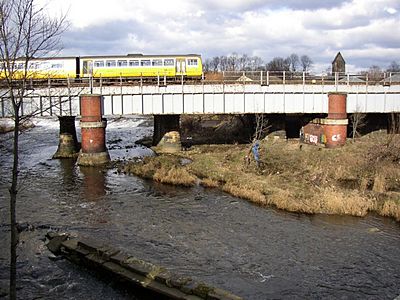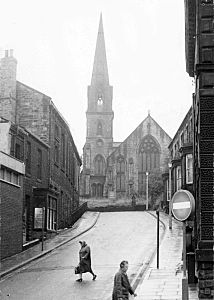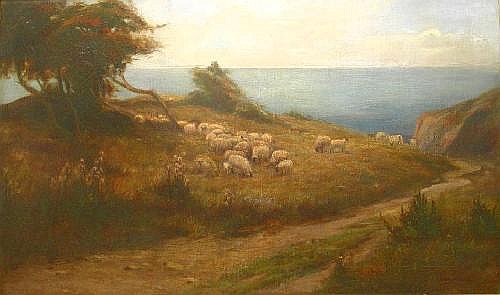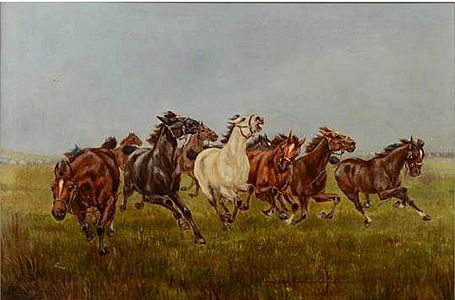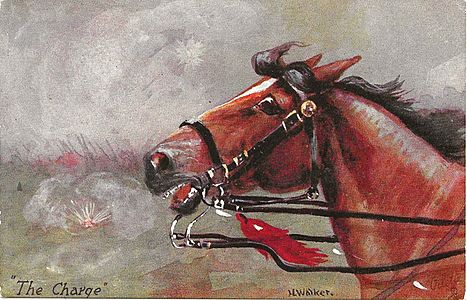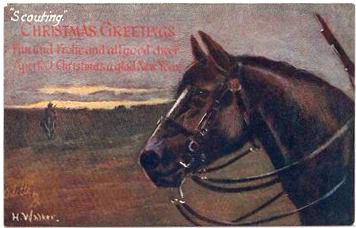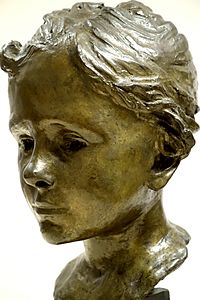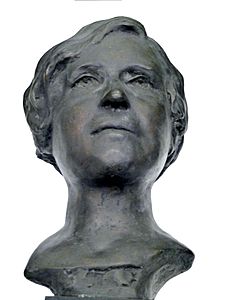Hilda Annetta Walker facts for kids
Quick facts for kids
Hilda Annetta Walker
|
|
|---|---|

Hilda Walker
|
|
| Born | 1877 Mirfield, West Riding of Yorkshire, England
|
| Died | 3 June 1960 (aged 82–83) |
| Nationality | British |
| Alma mater | Leeds College of Art |
| Known for | Sculpture, paintings of Wharfedale, portraits of horses |
| Style | Figurative painting |
Hilda Annetta Walker (1877 – 3 June 1960) was an English sculptor and painter. She was known for her landscapes, seascapes, and paintings of horses. Hilda was active as an artist from 1902 to 1958.
She also worked as a war artist in England during both the First and Second World Wars. Some of her early work included painting postcards for a company called Raphael Tuck & Sons. These postcards often showed firemen and horses.
Hilda was born in Mirfield, Yorkshire, England. Her family made blankets and supported her art education. She studied at Leeds College of Art. There, she learned from artists like William Gilbert Foster and William Charles Holland King. She usually signed her artworks "Hilda Walker" or "Hilda A. Walker".
Hilda had several siblings, including Ronald Walker and Eric Walker. The artist Marie Walker Last was her niece.
Contents
Family and Early Life
A Family of Manufacturers
Hilda Walker grew up in the industrial north of England during the 1800s. Her family had a long history in the blanket-making business. Her father, grandfather, and even earlier relatives were all involved in manufacturing.
Her family believed in hard work and supported education. This helped Hilda get the art training she needed. Her father, John Ely Walker, was a co-owner of James Walker & Sons. This company made rugs and carpets and employed 500 people by 1914. He was also a local leader and helped found a church.
Hilda and Her Siblings
Hilda was one of eleven children, and many of her siblings achieved great things.
- Her brother James was a colonel and a local leader.
- Sir Ronald Fitz-John Walker was a chairman of the Liberal Party.
- Reginald Firth and Eric Walker both received military awards in the First World War. Eric was also an RAF flying officer.
- Cyril Gordon was killed in the First World War.
- Her sister Ethel Atkinson was a local councilor.
- Dora Muriel Walker was the first woman to run a fishing trawler from Whitby. She also helped during both World Wars.
- Kathleen Marguerite was a journalist and author.
Hilda studied painting and sculpture at Leeds College of Art. Some people think she might have also studied art in London.
Life as an Artist
Between the Wars
Hilda lived with her parents in Knowl House, Mirfield, until the 1930s. The Walker family later gave this large house to the people of Mirfield in 1943. Hilda also had a studio in Hebden, where she worked from 1921 to 1955. She sometimes lived in both places at the same time.
During this period, Hilda also took part in public events. For example, in 1925, she opened a sale for the Liberal Club in Cleckheaton.
Second World War Efforts
During the Second World War, Hilda painted war scenes. She also took part in public events to support the war effort. In May 1941, she opened a war photographs exhibition in Mirfield. She also praised the artwork of the school children there.
In January 1942, Hilda gave pieces of blanket from her father's factory to a hospital supply depot. These were sewn together to make blankets for those in need. One of these blankets was even given to the Princess Royal (who later became Elizabeth II). In May 1943, Hilda presented art prizes at an RAF exhibition. This was part of a campaign to raise money for the war.
After the War
After the war, Hilda and her brother Hubert gave several artworks to public art galleries. They donated paintings to Doncaster Museum and Art Gallery. Hilda also gave a painting by her teacher, William Gilbert Foster, to Kirklees Museums and Galleries.
Later Life and Passing
Hilda Walker passed away on June 3, 1960, at the age of 82. She died at a nursing home in Heaton, Bradford. She left her money to her sister Dora. Hilda's niece, Marie Walker Last, used Hilda's house in Hebden after her death.
Artistic Career and Style
Hilda Walker had studios in London, including one near Haverstock Hill. She was a Fellow of the Royal Society of Arts. She was also a member of the Forum Club and an Associate of the Society of Women Artists.
In Yorkshire, Hilda was known for her sculptures and painted panels. She also created oil paintings and watercolours. Her paintings often showed views of Wharfedale and portraits of horses. She also made miniatures and prints.
Her sculptures were often portraits of people or figures, made from bronze and marble. Hilda was a figurative artist, meaning she painted or sculpted things that looked real. She believed that art should be clear and easy to understand. She once said that some modern art was so unclear, you needed a catalogue to know what it was!
A print of Hilda's painting A Prairie Fire was published in The Boy's Own Paper many years ago.
Notable Works and Exhibitions
Hilda Walker created many sculptures. Some of her well-known works include Pixie, The Water Baby, Dian, and Sleep.
Examples of Her Art
Art Exhibitions
Hilda Walker showed her art at the Royal Academy of Arts in London and in Paris. She also exhibited at many other places:
- Leeds Art Gallery: She showed Shere Khan (1901), a painting of a well-known animal.
- Cartwright Hall, Bradford: She exhibited many works here from 1902 to 1955. These included sculptures like Peter Pan and portraits like Col. James Walker, DSO, DL.
- London Salon of the Allied Artists Association: In 1909, she showed The Sands O' Dee and Shere Khan.
- Former Walker Galleries, London: In 1910, she had a show with Lester Sutcliffe. She displayed her unique monotypes, which are prints made from a single plate.
- Royal Academy Summer Exhibition, London: In 1921, she showed a bronze sculpture of her brother, Lieut.-Col. James Walker D.S.O.
- Royal Birmingham Society of Artists: She exhibited sculptures like Across the Sands O' Dee (1923) and Sleep (1924).
- Former Graham Gallery, London: In 1925, she showed twenty bright watercolours of gardens.
- Mirfield Society Exhibition: In 1928, she displayed paintings and sculptures, including a bronze figure of her father.
- United Artists' Society exhibition, London: In 1941, she showed war paintings like Young England and Skipper Dora. The Bradford Observer called it a "pleasant escapist show".
- Forum Club, London: In 1949, she showed sculptures, watercolours, and paintings on wood panels. One painting, Lovely Cottage, showed her own cottage in Hebden.
- Society of Women Artists: From 1950 to 1958, she exhibited various works, including bronzes and a marble sculpture called Ophelia.
Art in Public Collections
You can find Hilda Walker's art in these public collections:
- The sculpture Peter Pan is at Cartwright Hall in Bradford.
- The sculpture Miss Estelle Stead (from 1939) is at The Hepworth Wakefield.


